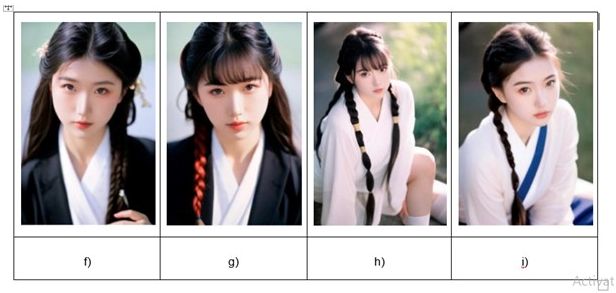In recent days, Beijing Internet Court released its decision relating to an infringement claim against an AI generated photo, confirming the copyrightability of the AI generated photo, and therefore ruling for infringement.
Taking aside the fact that the photo is generated by AI, the case is simple: the plaintiff, Mr Li, used the AI software Stable Diffusion to generate a photo by entering keywords and published it on his account of Little Red Book, a notorious social media in China.
One week later, he found that this exact photo was used as an insert of the article by another person (the defendant in the court case), without authorization, on its Baijiahao Account (another Chinese social media). Therefore, the plaintiff initiated the copyright infringement claim.
During the litigation, the plaintiff described the tools he used and made a detailed demonstration of the process for generating the photo, specifically:
1. Stable Diffusion Aki 4.2 (the version of the Stable Diffusion Open source in the package developed by an individual named Aki);
2. Two models developed specifically for generating Asian Females (published by a Bilibili user named K43), using "AsiaFacemix-pruned-fix.safetensors", "lora-hanfugirl-v1-5.safetensors";
3. Below process were further developed / setup by the plaintiff to "create" the work at issue:
a) Around 20 keywords for Prompt: ultra-photorealistic: 1.3), extremely high quality highdetail RAW color photo, in locations, Japan idol, highly detailed symmetrical attractive face, angular symmetrical face, perfect skin, skin pores, dreamy black eyes, reddish-brown plaits hairs, uniform, long legs, thighhighs, soft focus, (film grain, vivid colors, Film emulation, kodak gold portra 100, 35mm, canon50 f1,2), Lens Flare, Golden Hour, HD, Cinematic, Beautiful Dynamic Lighting
b) Around 120 keywords were used for Negative Prompt: ((3d, render, cg, painting, drawing, cartoon, anime, comic:1,2)), bad anatomy, bad hands, text, error, missing fingers, extra digit, fewer digits, cropped, worst quality, signature, watermark, username, blurry, artist name, (long body), bad anatomy, liquid body, malformed, mutated, bad proportions, uncoordinated body, unnatural body, disfigured, ugly, gross proportions, mutation, disfigured, deformed, (mutation), (child:1,2), b&w, fat, extra nipples, minimalistic, nsfw, lowres, bad anatomy, bad hands, text, error, missing fingers, extra digit, fewer digits, cropped, worst quality, low quality, normal quality, jpeg artifacts, signature, watermark, username, blurry, disfigured, kitsch, ugly, oversaturated, grain, low-res, Deformed, disfigured, poorly drawn face, mutation, mutated, extra limb, ugly, poorly drawn hands, missing limb, floating limbs, Disconnected limbs, malformed hands, blur, out of focus, long neck, long body, ugly, disgusting, poorly drawn, childish, mutilated, mangled, old, surreal, text, b&w, monochrome, conjoined twins, multiple heads, extra legs, extra arms, meme, elongated, twisted, fingers, strabismus, heterochromia, closed eyes, blurred, watermark, wedding, group, dark skin, dark-skinned female, tattoos, nude, lowres, bad anatomy, bad hands, text, error, missing fingers, extra digit, fewer digits, cropped, worst quality, low quality, normal quality, jpeg artifacts, signature, watermark, username, blurry"
c) Set the Sampling Step as 33
d) Set the Height as 768
e) Set the CFG Scale as 9
f) Set the Seed as 2692150200
g) Set the weight for model "land-hanfugirl-v1-5.safetensors" in "Additional-Networks"
h) Modify the Seed as 2692150199
i) Add several keywords in Prompt: "shy, elegant, cute, lust, cool pose, teen, viewing at camera, masterpiece, best quality"
Starting from step f), below photos has been generated as a result.

4. The court also made examination on legal terms and conditions of Stable Diffusion Open Source (the AI tool) and particularly on art. 6, which records: "The Output You Generate. Except as set forth herein, Licensor claims no rights in the Output You generate using the Model. You are accountable for the Output you generate and its subsequent uses. No use of the output can contravene any provision as stated in the license."
The court applied the 4-step test in ruling the copyrightability of the work.
1. Whether the work is within the scope of literature, art and science; (Yes)
2. Whether the work possesses originality; (Yes)
3. Whether the work has a certain form of expression; (Yes)
4. Whether the work is a result of intellectual achievement. (Yes)
The court believe the answer for test 1 and 3 is obvious, given that the appearance of the work is no different than the usual photos or paintings.
Intellectual Achievement. The court analyses that the image is not an existing image returned by search engine, nor it is a combination of various elements preset by the software designer.
In simple terms, the role or function of the model is similar to that of humans who have acquired certain abilities and skills through learning and accumulation. It can generate corresponding images based on human input text descriptions, substituting drawing lines and coloring by human, then present human creativity and ideas in a tangible way.
The plaintiff put in prompt words in describing the subject, details of the figure, environment, poses and style, then he adjusts the parameter and add several prompt words based on the photo preliminarily generated, and finally he selected a photo that he's satisfied with.
Viewing the process, the plaintiff made a certain amount of intellectual investment, such as designing the presentation of characters, selecting prompt words, arranging the order of prompt words, setting relevant parameters, selecting which image meets expectations, etc.
The photo at issue reflected the plaintiff's intellectual investment, therefore it shall be considered a result of intellectual achievement.
Originality. The court analyses that in general, the more diverse the requirements, the clearer and more specific the descriptions of image elements, layout, and composition are, and the more personalized their expression can be reflected.
The plaintiff designed visual elements such as characters and their presentation through prompt words, and set parameters for screen layout and composition, reflecting the plaintiff's selection and arrangement.
In the meantime, the plaintiff obtained the first image by inputting prompt words and setting relevant parameters. He continued to add prompt words and modify parameters, continuously adjusting and correcting them, and finally obtained the photo at issue. This adjustment and correction process also reflects the plaintiff's aesthetic choice and personal decision.
The court therefore ruled that the photo at issue possesses originality.
The court also made a Policy Concern analysis.
Generative artificial intelligence technology has brought about changes in people's creative methods, which is similar to the impact of many technological advancements in history. The process of technological development is the gradual outsourcing of human work to machines.
Before the emergence of cameras, people needed to use advanced painting skills to reproduce images, and the emergence of cameras made it easier to record objective images. Now, the photography function of smartphones is becoming more and more powerful, and it is becoming simpler to use. And as long as the photos taken with smartphones reflect the photographer's originality and intellectual investment, it will be considered work of photography and therefore protected by copyright law.
Therefore, the more advanced the technology and more intelligent the tools are, the less investment by human is needed.
The court made an analogy between using AI to generate the photo and entrusting an artist to paint a drawing, considering them similar. A big difference is that an artist has his own free will in selection and judgement and therefore can be considered a creator of the work while AI does not. The court therefore analyses that using AI to generate photo shall still be considered human using tools for creation, meaning that human is the entity making intellectual investment instead of AI.
The court believes that encouraging more people to use latest tools for creation will benefit the creation of work and the development of AI technology, and therefore as long as the AI generated photos possesses original intellectual investment, it can be considered a work.
HFG Comment
We believe the court is making analogy for the copyrightability in usage of AI in generating photos and copyrightability in the usage of camera in taking photos, where the latter was also highly controversial over a hundred years ago. It seemed to us the court is saying, back then we pro for photography, and in the same way we shall pro for AI.
We also noticed a contrary decision was made in US in Aug 2023, where the judge (and US Copyright Office) ruled that works generated entirely by artificial intelligence are not copyrightable for lack of human authorship.
The content of this article is intended to provide a general guide to the subject matter. Specialist advice should be sought about your specific circumstances.


